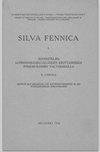在平坦和潮湿的地形上用电缆堆场提取木材:电缆堆场制造商的经验调查
IF 1.7
3区 农林科学
Q2 FORESTRY
引用次数: 17
摘要
电缆堆场是在地面机械无法到达的地点进行负载处理的一般解决方案,通常与陡峭的地形有关。在平坦的地形上,这种情况主要出现在柔软或潮湿的土壤上,最常见于中欧和北欧国家。如今,变化的环境和市场条件可能为在商业作业中在平坦地形上实际实施电缆分拣提供了前所未有的机会。研究的目的是收集电缆码垛制造商在平坦地形上使用和适应电缆码垛技术的经验。对欧洲电缆分拣技术制造商进行了采访,内容涉及客户体验、特殊挑战、适应潜力、未来潜力以及在平坦地形上扩展电缆分拣技术的主要障碍。几乎所有的制造商都收到了平地堆码技术解决方案的请求,主要来自德国。暂时或永久无法进入、监管或环境原因是考虑电缆布线技术的最常见动机。安装被认为特别具有挑战性(间隙、稳定锚定)。潜在的改进包括更高的塔、人工锚、开采前的机械化捆束和无基码系统。一个人工的、高度可移动的、自锚的尾梁被认为是最有用的适应。虽然担心有限的盈利能力和合格的劳动力短缺,但大多数制造商对在平坦地形上扩大电缆布线表现出积极或中立的看法。然而,只要可以采用地面系统,而且电缆敷设没有补贴,电缆敷设就不被认为具有成本竞争力。本文章由计算机程序翻译,如有差异,请以英文原文为准。
Timber extraction by cable yarding on flat and wet terrain: a survey of cable yarder manufacturer’s experience
Cable yarding is a general solution for load handling on sites not accessible to ground-based machinery, and is typically associated with steep terrain. On flat terrain, such conditions can primarily be found on soft or wet soils, most frequently encountered in Central and Northern European countries. Today, changed environmental and market conditions may offer an unprecedented opportunity to the actual implementation of cable yarding on flat terrain in commercial operations. The study goal was to collect cable yarder manufacturers experience regarding the use and adaption of cable yarding technology on flat terrain. European manufacturers of cable yarding technology were interviewed about customer experience, particular challenges, adaptation potential, future potential and main hurdles for the expansion of cable yarding on flat terrain. Almost all manufacturers have received requests for flat-terrain yarding technology solutions, primarily from Germany. Temporal or permanent inaccessibility, regulatory or environmental reasons were the most frequent motivation for considering cable yarding technology. Installation was considered particularly challenging (clearance, stable anchoring). Potential adaptations included higher towers, artificial anchors, mechanized bunching before extraction and un-guyed yarder-systems. An artificial, highly mobile, self-anchoring tail spar was considered the most useful adaptation. While concerned about limited profitability and qualified labour shortage, most manufacturers demonstrated a positive or neutral view concerning the expansion of cable yarding on flat terrain. However, cable yarding is not considered to be cost-competitive wherever ground-based systems can be employed and cable yarding is not subsidized.
求助全文
通过发布文献求助,成功后即可免费获取论文全文。
去求助
来源期刊

Silva Fennica
农林科学-林学
CiteScore
3.50
自引率
11.10%
发文量
21
审稿时长
3 months
期刊介绍:
Silva Fennica publishes significant new knowledge on forest sciences. The scope covers research on forestry and forest ecosystems. Silva Fennica aims to increase understanding on forest ecosystems, and sustainable use and conservation of forest resources. Use of forest resources includes all aspects of forestry containing biomass-based and non-timber products, economic and social factors etc.
 求助内容:
求助内容: 应助结果提醒方式:
应助结果提醒方式:


